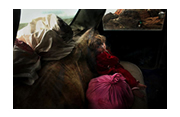Child Survival in a Changing Climate
Project location: Worldwide, Various Countries
Project start date: August 2010 -
Project end date: August 2012
Project number: 2010-24
Beneficiary: Associazione Witness Image
NEPAL REPORT
Glacial Lake Outburst Floods in Nepal
The climate change correlated with increasing temperature of the planet is causing the retreat of glaciers in the mountain range of the Himalayas, creating a worrying rise of the water level. The last stop of this exciting photographic expedition on climate change was in Nepal.
Luca Catalano went to Lake Tsho Rolpa, the largest and most dangerous glacial lake in Nepal that is located in the Rolwaling Valley, approximately 30 km southwest of Mt. Everest.It has formed over the last forty years as the Trakarding Glacier has stagnated, melted and retreated. The lake, which is at an elevation of 4580metres, is approximately 3 km long, 0.5 km wide and up to 130 m deep. It is retained by a natural moraine dam that is unstable and threatens to burst. If the dam is breached, the resulting flood of approximately 80 million cubic metres of water would cause serious damage for 100 km or more downstream, threatening as many as 6000 lives. It also threatens the construction site of a 60 MegaWatt hydroelectric project and other infrastructure. The damage would have a serious impact on the economy of Nepal. The current risk of a failure is considered to be high and increasing rapidly.
Luca Catalano spent 20 days to reach the lake Tso Rolpa, crossing the great Rolwalling valley, where are located many villages threatened by the same lake. The goal for the environmental engineers would be to lower the lake by 30 metres. While waiting for the engineers to be able to find a way to lower the water level, Lake Tsho Rolpa currently is surrounded with sensors and alarms that are connected to sirens in the villages in danger. They can give advance notice only 10 minutes which is too short for a possible evacuation.
According to some of the photographer's interviews with farm families who live in the Rolwaling Valley, there is a serious concern for their and their children's future survival. They are afraid that the lake could overflow, in case of earthquakes and/or abundant rainfall during the monsoon season. They also fear that the flooding can happen at night because all the villages in the valley, are without electricity. They are aware that they have only a few minutes to try and get up the mountains surrounding the valley. Whole families of farmers living in the Rolwaling Valley, are therefore seriously worried about their and their children's future survival. Still, they are forced to remain in their villages, as the only source of income, besides the care of yaks, is the cultivation of potatoes.






